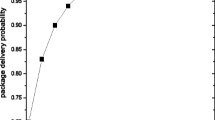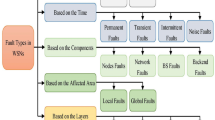Abstract
Through the use of UAV, the functional lifetime of WSN can be elongated in exchange for higher data delivery latency as the UAV replaces the multi-hop communication among nodes during data acquisition. Due to the NP-hardness of the TSP whose computational complexity increases exponentially as an increment of number of nodes, heuristic algorithms, such as nearest neighbor heuristic TSP algorithm (NN), have been developed for reducing this data delivery latency in shortest possible time. In our previous research work we have published the directional NN algorithm directed to the next nearest node (DDNN) (Alemayehu and Kim in Wirel Pers Commun 95:3271–3285, 2017) which modifies the existing NN algorithm to gain a reduction in this data delivery latency. However, the DDNN algorithm does not consider the reliability of the system in case of node or link failures. To collect the sensing data rapidly and reliably, the DDNN algorithm should be able to react to node or link failures and manage the data transmissions effectively in the network. In this study, we propose an extension of the DDNN scheme, fault tolerable DDNN scheme for data gathering to gain a reduction in the data acquisition time with fault-tolerant capability. The performance analysis has demonstrated that our proposed algorithm tolerates fault in case of malfunctions of sensors due to node/link failures and improves the detection rate of the DDNN scheme up to 34.93% at the cost of a little bit distance.











Similar content being viewed by others

References
Lin, C., Xiong, N., Park, J. H., & Kim, T. (2009). Dynamic power management in new architecture of wireless sensor networks. International Journal of Communication Systems, 22, 671–693.
Wu, X., Chen, G., & Das, S. K. (2008). Avoiding energy holes in wireless sensor networks with non-uniform node distribution. IEEE Transactions on Parallel and Distributed Systems, 19, 710–720.
Lai, C., Hwang, D. D., Kim, S. P., & Verbauwhede, I. (2004). Reducing radio energy consumption of key management protocols for wireless sensor networks. In Proceedings of the ACM/IEEE International symposium on low power electronics and design (ISLPED) (pp. 351–356).
Cobano, J. A., Martínez-de Dios, J. R., Conde, R., Sánchez-Matamoros, J. M., & Ollero, A. (2010). Data retrieving from heterogeneous wireless sensor network nodes using UAVs. Journal of Intelligent and Robotic Systems, 60, 133–151.
de Freitas, E. P., Heimfarth, T., et al. (2010). UAV relay network to support WSN connectivity. In Proceedings of IEEE international congress on ultramodern telecommunications and control systems (ICUMT’10) (pp. 309–314).
Sugihara, R., & Gupta, R. K. (2009). Optimizing energy-latency trade-off in sensor networks with controlled mobility. In IEEE INFOCOM (pp. 2566–2570).
Ho, D. T., Grøtli, E. I., Shimamoto, S., & Johansen, T. A. (2012). Optimal relay path selection and cooperative communication protocol for a swarm of UAVs. In Proceedings of the 3rd international workshop on wireless networking & control for unmanned autonomous vehicles: Architectures, protocols and applications (pp. 1585–1590).
Sujit, P. B., Lucani, D. E., & Sousa, J. B. (2012). Bridging cooperative sensing and route planning of autonomous vehicles. IEEE Journal on Selected Areas in Communications, 30, 912–922.
Flushing, E. F., Gambardella, L., & Di Caro, G. (2012). Search and rescue using mixed swarms of heterogeneous agents: Modeling, simulation, and planning. IDSIA/USI-SUPSI, Technical Report.
Frew, E. W., & Brown, T. X. (2008). Networking issues for small unmmaned aircraft systems. Journal of Intelligent and Robotic Systems, 54, 21–37.
Ruz, J. J., Arevalo, O., Pajares, G., & De la Cruz, J. M. (2009). UAV trajectory planning for static and dynamic environments. InTech, 27, 581–600.
Alemayehu, T. S., & Kim, J. H. (2017). Efficient nearest neighbor heuristic TSP algorithms for reducing data acquisition latency of UAV relay WSN. Wireless Personal Communications, 95, 3271–3285.
Tekdas, O., Isler, V., Lim, J. H., & Terzis, A. (2009). Using mobile robots to harvest data from sensor fields. IEEE Wireless Communications in Robotic Networks, 16, 22–28.
Yuan, B., Orlowska, M., & Sadiq, S. (2007). On the optimal robot routing problem in wireless sensor networks. IEEE Transactions on Knowledge and Data Engineering, 19, 1252–1261.
Papadimitriou, C. H. (1978). Euclidean traveling salesman problem is NP complete. In Theoretical computer science (pp. 237–244).
Lawler, E. L., Lenstra, J. K., Kan, A. H. G., & Shmoys, D. B. (1985). The traveling salesman problem: A guided tour of combinatorial optimization. New York: Wiley.
Wang, J., Cao, Y., Li, B., Kim, H.-J., & Lee, S. (2017). Particle swarm optimization based clustering algorithm with mobile sink for WSNs. Future Generation Computer Systems, 76, 452–457.
Yue, Y.-G., & He, P. (2018). A comprehensive survey on the reliability of mobile wireless sensor networks: Taxonomy, challenges, and future directions. Information Fusion, 44, 188–204.
Szewczyk, R., Polastre, J., Mainwaring, A., & Culler, D. (2004). Lessons from a sensor network expedition. In Proceedings of the first European workshop on sensor networks (EWSN) (pp. 307–322).
Liu, H., Nayak, A., & Stojmenovic, I. (2009). Fault tolerant algorithms/protocols in wireless sensor networks. In Guide to wireless sensor networks (pp. 261–291). London: Springer.
Thelen, J., Goense, D., & Langendoen, K. (2005). Radio wave propagation in potato fields. In First workshop on wireless network measurement (2005).
Afsar, M. (2015). A comprehensive fault-tolerant framework for wireless sensor networks. Security and Communication Networks, 8(17), 3247–3261.
Salayma, M., Al-Dubai, A. Y., Romdhani, I., & Nasser, Y. (2017). Wireless body area network (WBAN): A survey on reliability, fault tolerance, and technologies coexistence. ACM Computing Surveys, 50, 1–38.
Lussier, B., Chatila, R., Ingrand, F., Killijian, M.-O., & Powell, D. (2004). On fault tolerance and robustness in autonomous systems. In 3rd IARP-IEEE/RAS-EURON joint workshop on technical challenges for dependable robots in human environments.
Intanagonwiwat, C., Govindan, R., Estrin, D., Heidemann, J., & Silva, F. (2002). Directed diffusion for wireless sensor networking. ACM/IEEE Transactions on Networking, 11, 2–16.
Karlof, C., Li, Y., & Polastre, J. (2003). ARRIVE: Algorithm for robust routing in volatile environments. Technical Report UCB//CSD-03-1233, University of California, Berkeley, CA.
Costa, D. G., Vasques, F., & Portugal, P. (2017). Enhancing the availability of wireless visual sensor networks: Selecting redundant nodes in networks with occlusion. Applied Mathematical Modelling, 42(1), 223–243.
Jafarali Jassbi, S., & Moridi, E. (2019). Fault tolerance and energy efficient clustering algorithm in wireless sensor networks: FTEC. Wireless Personal Communications, 107(1), 373–391.
Tien, N. X., Kim, S., Rhee, J. M., & Park, S. Y. (2017). A novel dual separate paths (DSP) algorithm providing fault-tolerant communication for wireless sensor networks. Sensors, 17, 1699.
Cheraghlou, M. N., Khadem-Zadeh, A., & Haghparast, M. (2017). Increasing lifetime and fault tolerance capability in wireless sensor networks by providing a novel management framework. Wireless Personal Communications, 92, 603–622.
Moridi, E., Haghparast, M., Hosseinzadeh, M., & Jassbi, S. J. (2020). Novel fault-tolerant clustering-based multipath algorithm (FTCM) for wireless sensor networks. Telecommunication Systems. https://doi.org/10.1007/s11235-020-00663-z.
McGough, J., Smotherman, M., & Trivedi, K. S. (1985). The conservativeness of reliability estimates based on instantaneous coverage. IEEE Transactions on Computers, C-34(7), 602–608.
Acknowledgements
This research was supported by Basic Science Research Program through the National Research Foundation of Korea (NRF) funded by the Ministry of Education (No. NRF-2018R1D1A1B07040573).
Author information
Authors and Affiliations
Corresponding author
Additional information
Publisher's Note
Springer Nature remains neutral with regard to jurisdictional claims in published maps and institutional affiliations.
Rights and permissions
About this article
Cite this article
Alemayehu, T.S., Kim, JH. & Yoon, W. Fault-Tolerant UAV Data Acquisition Schemes. Wireless Pers Commun 114, 1669–1685 (2020). https://doi.org/10.1007/s11277-020-07445-5
Published:
Issue Date:
DOI: https://doi.org/10.1007/s11277-020-07445-5



